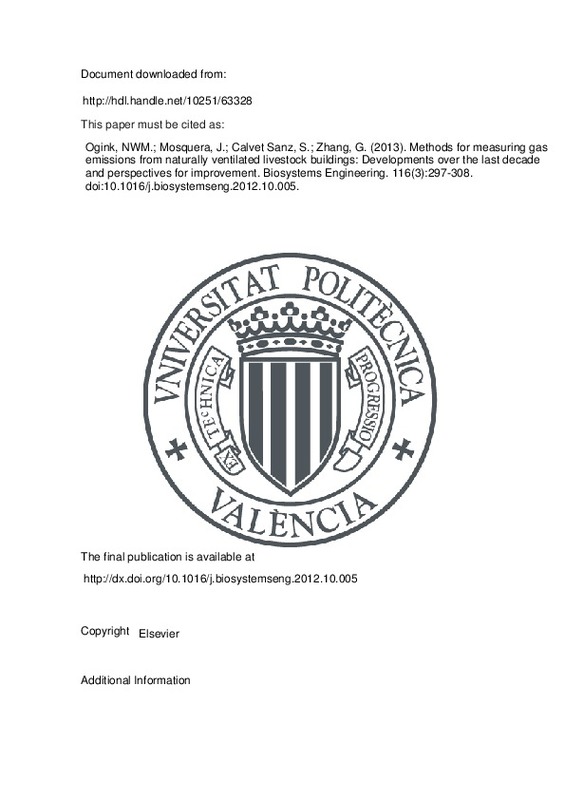JavaScript is disabled for your browser. Some features of this site may not work without it.
Buscar en RiuNet
Listar
Mi cuenta
Estadísticas
Ayuda RiuNet
Admin. UPV
Methods for measuring gas emissions from naturally ventilated livestock buildings: Developments over the last decade and perspectives for improvement
Mostrar el registro sencillo del ítem
Ficheros en el ítem
| dc.contributor.author | Ogink, Nico W. M.
|
es_ES |
| dc.contributor.author | Mosquera, Julio
|
es_ES |
| dc.contributor.author | Calvet Sanz, Salvador
|
es_ES |
| dc.contributor.author | Zhang, Guo-Qiang
|
es_ES |
| dc.date.accessioned | 2016-05-02T10:49:14Z | |
| dc.date.available | 2016-05-02T10:49:14Z | |
| dc.date.issued | 2013-11 | |
| dc.identifier.issn | 1537-5110 | |
| dc.identifier.uri | http://hdl.handle.net/10251/63328 | |
| dc.description.abstract | [EN] The objectives of this paper are: 1) to give an overview of the development of methods for measuring emission rates from naturally ventilated livestock buildings over the last decade, 2) to identify and evaluate strengths and weaknesses, 3) to summarise and conclude the current state-of-art of available measurement concepts and their perspectives for improvement. The methods reviewed include determination of concentration and air exchange rate separately, tracer gas ratio, passive flux samplers, flux chambers, and combined downwind measurement and dispersion modelling. It is concluded that passive flux samplers, flux chambers and combined measurement and dispersion modelling are useful, but for limited fields of application only and require further development and validation against reference methods. The most robust method to investigate emission rates available at this stage is the tracer gas ratio method, but improvements are required. They include more detailed estimates of CO2 release rates (when using CO2 as a tracer) and research into optimising dosing performance of tracer gas release systems. The reliability of tracer gas ratio methods applied in buildings with large ventilation openings needs to be improved by a more profound understanding of tracer-pollutant ratios and their spatial variability, and the development of improved sampling methods for concentration ratios. There is a need for a field reference method against which other methods can be evaluated. None of the diicussed measurement methods can be marked as a solid reference for all conditions; tracer gas ratio methods are the most likely candidate but need further improvement. (C) 2012 IAgrE. Published by Elsevier Ltd. All rights reserved. | es_ES |
| dc.description.sponsorship | The contribution to this paper of N. Ogink and J. Mosquera was financially supported by the Netherlands Ministry of Infrastructure and Environment. | |
| dc.language | Inglés | es_ES |
| dc.publisher | Elsevier | es_ES |
| dc.relation.ispartof | Biosystems Engineering | es_ES |
| dc.rights | Reserva de todos los derechos | es_ES |
| dc.subject | Dairy-cattle buildings | es_ES |
| dc.subject | Milk urea concentration | es_ES |
| dc.subject | Ammonia emission | es_ES |
| dc.subject | Carbon-Dioxide | es_ES |
| dc.subject | Manure stores | es_ES |
| dc.subject | Gaseous emissions | es_ES |
| dc.subject | Animal houses | es_ES |
| dc.subject | CO2 balance | es_ES |
| dc.subject.classification | PRODUCCION ANIMAL | es_ES |
| dc.title | Methods for measuring gas emissions from naturally ventilated livestock buildings: Developments over the last decade and perspectives for improvement | es_ES |
| dc.type | Artículo | es_ES |
| dc.identifier.doi | 10.1016/j.biosystemseng.2012.10.005 | |
| dc.rights.accessRights | Abierto | es_ES |
| dc.contributor.affiliation | Universitat Politècnica de València. Departamento de Ciencia Animal - Departament de Ciència Animal | es_ES |
| dc.contributor.affiliation | Universitat Politècnica de València. Instituto de Ciencia y Tecnología Animal - Institut de Ciència i Tecnologia Animal | es_ES |
| dc.description.bibliographicCitation | Ogink, NWM.; Mosquera, J.; Calvet Sanz, S.; Zhang, G. (2013). Methods for measuring gas emissions from naturally ventilated livestock buildings: Developments over the last decade and perspectives for improvement. Biosystems Engineering. 116(3):297-308. https://doi.org/10.1016/j.biosystemseng.2012.10.005 | es_ES |
| dc.description.accrualMethod | S | es_ES |
| dc.relation.publisherversion | http://dx.doi.org/10.1016/j.biosystemseng.2012.10.005 | es_ES |
| dc.description.upvformatpinicio | 297 | es_ES |
| dc.description.upvformatpfin | 308 | es_ES |
| dc.type.version | info:eu-repo/semantics/publishedVersion | es_ES |
| dc.description.volume | 116 | es_ES |
| dc.description.issue | 3 | es_ES |
| dc.relation.senia | 250120 | es_ES |
| dc.identifier.eissn | 1537-5129 | |
| dc.contributor.funder | Ministry of Infrastructure and the Environment, Holanda |







![[Cerrado]](/themes/UPV/images/candado.png)

